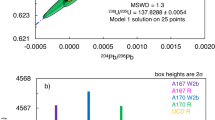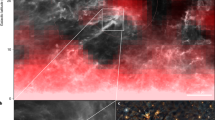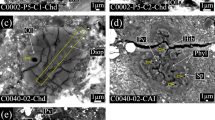Abstract
The radioactive decay of 26Al, to form 26Mg, may have constituted an important heat source for melting of small planetary bodies in the early Solar System. Although large excesses of radiogenic 26Mg, arising from in situ decay of 26Al (half life ~7.2 x 105 yr), have been found in ten carbonaceous and ordinary chondritic meteorites1,2, the distribution of 26Al in the solar nebula and its importance as a heat source remain to be determined. All previous observations of excess 26Mg are confined to Al-rich minerals in refractory, Ca,Al-rich inclusions (CAIs). An assessment of the distribution of 26Al in the Solar System from these data is difficult because CAIs are only a minor constituent of chondritic meteorites associated with high-temperature nebular processes, and because the initial 26Al/27Al ratio inferred from the CAI data is not constant3 but varies from the commonly measured value of ∼ 5 x 10−5 to values <1 x 10−7. Here we report the first observation of radiogenic 26Mg in non-refractory meteoritic material, a plagio-clase-bearing, olivine-pyroxene clast chondrule in the Semarkona ordinary chondrite. The inferred initial abundance of 26Al (26Al/27Al = (7.7±2.1)xl0−6) is sufficient to produce incipient melting in well insulated bodies of chondritic composition. We conclude that planetary accretion and differentiation must have begun on a timescale comparable to the half life of 26Al and that, even if widespread melting did not occur, 26Al heating played a significant role in thermal metamorphism on small planets.
This is a preview of subscription content, access via your institution
Access options
Subscribe to this journal
Receive 51 print issues and online access
$199.00 per year
only $3.90 per issue
Buy this article
- Purchase on SpringerLink
- Instant access to full article PDF
Prices may be subject to local taxes which are calculated during checkout
Similar content being viewed by others
References
Hutcheon, I. D., Armstrong, J. T. & Wasserburg, G. J. Lunar planet. Sci. XVII, 372–373 (1986).
Hinton, R. W. & Bischoff, A. Nature 308, 169–172 (1984).
Wasserburg, G. J. in Protostars and Planets II (eds Black, D. C. & Matthews, M.) 703–737 (Univ. of Arizona Press, Tucson, 1985).
Schramm, D. M., Tera, F. & Wasserburg, G. J. Earth planet. Sci. Lett. 10, 44–59 (1970).
Sears, D. W. et al. Nature 287, 791–795 (1980).
Hutchison, R. et al. Geochim. cosmochim. Acta 51, 1875–1882 (1987).
Hutcheon, I. D., Armstrong, J. T. & Wasserburg, G. J. Geochim. cosmochim. Acta 51, 3175–3192 (1987).
Zinner, E. & Crozaz, G. Int. J. Mass Spectr. Ion Proc. 69, 17–39 (1986).
Beckett, J. R. et al. Lunar planet. Sci. XIX, 49–50 (1988).
Dodd, R. T. Meteorites: A Petrologic-Chemical Synthesis (Cambridge Univ. Press, 1981).
Hutchison, R. & Bevan, A. W. R. in Chondrules and Their Origins (ed. King, E.) 162–179 (Lunar planet. Inst., Houston, 1983).
Prinz, M. & Keil, K. Phys. Chem. Earth 10, 215–237 (1977).
Ma, M.-S. & Schmitt, R. A. Meteoritics 14, 81–89 (1979).
Philpotts, J. A. et al. Proc. lunar Sci. Conf. 4th 1427–1436 (1973).
Lindstrom, M. M. et al. Proc. lunar Sci. Conf. 8th 2137–2151 (1977).
Shih, C. et al. Proc. lunar Sci. Conf. 6th 1255–1285 (1975).
Schnetzler, C. C. & Philpotts, J. A. Geochim. cosmochim. Acta 34, 333–340 (1970).
Carslaw, H. S. & Jaeger, J. C. Conduction of Heat in Solids 2nd Edn (Oxford Univ. Press, New York, 1959).
Author information
Authors and Affiliations
Rights and permissions
About this article
Cite this article
Hutcheon, I., Hutchison, R. Evidence from the Semarkona ordinary chondrite for 26A1 heating of small planets. Nature 337, 238–241 (1989). https://doi.org/10.1038/337238a0
Received:
Accepted:
Issue date:
DOI: https://doi.org/10.1038/337238a0
This article is cited by
-
Bubbles to Chondrites-II. Chemical fractionations in chondrites
Progress in Earth and Planetary Science (2021)
-
Early aqueous activity on the ordinary and carbonaceous chondrite parent bodies recorded by fayalite
Nature Communications (2015)
-
The history of ordinary chondrites from the data on stable isotopes of noble gases (a review)
Solar System Research (2005)
-
Core formation in planetesimals triggered by permeable flow
Nature (2003)
-
26Al as a heat source for early melting of planetesimals: Results from isotopic studies of meteorites
Journal of Earth System Science (1995)



